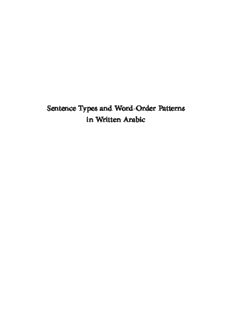Table Of ContentSentence Types and Word-Order Patterns
in Written Arabic
Studies in Semitic Languages
and Linguistics
Edited by
T. Muraoka and C.H.M. Versteegh
VOLUME 52
Sentence Types
and Word-Order Patterns
in Written Arabic
Medieval and Modern Perspectives
By
Yishai Peled
LEIDEN • BOSTON
2009
This book is printed on acid-free paper.
Library of Congress Cataloging-in-Publication Data
Peled, Yishai.
Word-order patterns in written Arabic : medieval and modern perspectives / by
Yishai Peled.
p. cm. — (Studies in semitic languages and linguistics)
Includes bibliographical references and index.
ISBN 978-90-04-17062-9 (hardback : alk. paper) 1. Arabic language—Word order.
2. Arabic language—Syntax. I. Title. II. Series.
PJ6151.P45 2008
492.7’5—dc22
ISSN 0081-8461
ISBN 978 90 04 17062 9
Copyright 2009 by Koninklijke Brill NV, Leiden, The Netherlands.
Koninklijke Brill NV incorporates the imprints Brill, Hotei Publishing,
IDC Publishers, Martinus Nijhoff Publishers and VSP.
All rights reserved. No part of this publication may be reproduced, translated,
stored in a retrieval system, or transmitted in any form or by any means, electronic,
mechanical, photocopying, recording or otherwise, without prior written permission
from the publisher.
Authorization to photocopy items for internal or personal use is granted by
Koninklijke Brill NV provided that the appropriate fees are paid directly to
The Copyright Clearance Center, 222 Rosewood Drive, Suite 910,
Danvers, MA 01923, USA.
Fees are subject to change.
printed in the netherlands
For Lia,
Einat and Amir,
Maya and Ayala
CONTENTS
Preface .................................................................................................. xi
Chapter One Introduction: Historical Background and
Modern Approaches ...................................................................... 1
1.1 Sentence types versus word-order patterns ..................... 1
1.2 The Sībawayhian legacy: the theory of ʿamal and
some of its concepts ............................................................ 4
1.3 Later grammarians on Arabic sentence types ................. 10
1.4 The medieval grammarians and general linguistics ....... 20
1.5 Some general notes relating to modern research into
Arabic sentence types and word-order patterns ............. 27
1.5.1 Terminological preliminary remarks ................... 27
1.5.2 Some modern conceptions and
methodologies .......................................................... 31
1.6 The aim of the present study and its organization ......... 44
1.7 Summary ............................................................................... 46
Chapter Two Type-1 Sentences: Verb+Subject .......................... 49
2.1 The concept of basic word order ....................................... 49
2.2 The medieval grammarians’ concept of taqdīm
wa-taʾxīr ................................................................................. 53
2.2.1 The problem ............................................................. 53
2.2.2 The movement hypothesis ..................................... 56
2.2.3 The evidence: Sībawayhi ........................................ 57
2.2.4 The evidence: later grammarians .......................... 59
2.3 The grammarians’ formal account of VSO/VOS ............ 65
2.4 Pragmatic and textual aspects ............................................ 76
2.4.1 Medieval grammarians ........................................... 76
2.4.2 Modern writers ........................................................ 80
2.5 Summary ............................................................................... 82
Chapter Three Type-2 Sentences: Subject+Predicate ................ 83
3.1 Types of xabar: an overview .............................................. 83
3.2 Verbless sentence versus single-phrased xabar ............... 87
3.3 SVO and left-dislocation versus clausal xabar ................ 89
viii contents
3.3.1 The concept of clausal xabar in the medieval
grammarians’ writings ............................................ 89
3.3.2 Modern approaches versus the medieval
tradition .................................................................... 96
3.4 Functional Aspects ............................................................... 111
3.4.1 General principles ................................................... 111
3.4.2 Indefinite mubtadaʾ in the medieval tradition ... 114
3.4.3 S2 with a focus function ........................................ 116
3.5 Mubtadaʾ-xabar (S2-P2) inversion .................................... 121
3.6 Copula versus ḍamīr al-fasḷ ................................................ 126
3.6.1 Medieval grammarians: ḍamīr al-fasḷ .................. 126
3.6.2 Modern writers: copula .......................................... 131
3.7 Summary ............................................................................... 134
Chapter Four Problems in the Theory of Sentence Types ....... 137
4.1 Introduction .......................................................................... 137
4.2 Qāʾimun Zaydun .................................................................. 138
4.3 Fīhā/fī l-dāri Zaydun ........................................................... 147
4.3.1 Sībawayhi .................................................................. 148
4.3.2 The istaqarra/mustaqirrun hypothesis ................. 152
4.3.3 ʾAbū ʿAlī l-Fārisī ...................................................... 156
4.4 Obligatory fronting of the xabar ....................................... 159
4.4.1 Formal aspects ......................................................... 159
4.4.2 Fī l-dāri rajulun—pragmatic aspects .................... 165
4.5 Ibn Hišām’s tripartite division ........................................... 167
4.5.1 Background .............................................................. 167
4.5.2 Ibn Hišām’s categorization and definitions ......... 169
4.5.3 Problems ................................................................... 175
4.6 Modern approaches ............................................................. 179
4.7 Summary ............................................................................... 183
Chapter Five Extended Versions of Type-2 and Type-3
Sentences ......................................................................................... 187
5.1 Introduction .......................................................................... 187
5.2 Nawāsix al-ibtidāʾ ................................................................. 188
5.3 The verbal status of kāna and “sisters” ............................. 193
5.4 Word-order variations in kāna and ʾinna sentences ...... 202
5.5 Modern approaches ............................................................. 209
5.6 Non-referential formatting device versus ḍamīr
al-šaʾn ..................................................................................... 212
contents ix
5.6.1 Ḍamīr al-šaʾn in medieval Arabic grammatical
tradition .................................................................... 212
5.6.2 Modern approaches to ḍamīr al-šaʾn ................... 219
5.7 Summary ............................................................................... 223
Summary and Conclusions .............................................................. 225
Bibliographical References ................................................................ 229
Primary sources ............................................................................. 229
Secondary sources ......................................................................... 230
Index .................................................................................................... 237
Description:Sentence types and word-order patterns in Arabic have been a matter of debate and controversy for a long period of time. They were hotly discussed by the medieval Arab grammarians and continue to be a major topic of discussion among modern scholars. This book describes the development of the medieva

